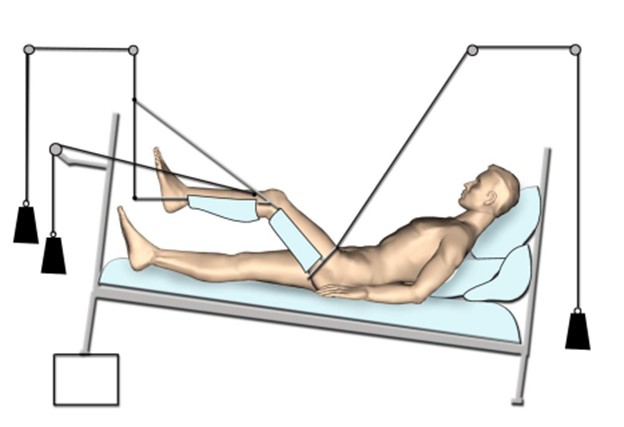A nurse is discussing Russell's traction with a newly licensed nurse. Which of the following statements about this form of traction should the nurse include in the teaching?

Russell's traction uses skeletal pins to stabilize the fracture.
Russell's traction uses a pelvic girdle belt to decrease lower back pain.
Russell's traction uses a sling under the knee to treat a fracture of the femur.
Russell's traction uses a cervical halter to decrease cervical muscle spasms.
The Correct Answer is C
A. Russell's traction does not use skeletal pins. Skeletal traction involves the use of pins, wires, or screws inserted directly into the bone to stabilize a fracture.
B. Russell's traction does not involve the use of a pelvic girdle belt. Pelvic girdle belts are more commonly associated with some other forms of traction used for different purposes.
C. Russell's traction is specifically used for the treatment of a fracture of the femur, and it involves a sling placed under the knee to support and immobilize the affected leg.
D. Russell's traction is not used to decrease cervical muscle spasms. Cervical traction, using a cervical halter, is a separate form of traction used for cervical spine-related issues.
Nursing Test Bank
Naxlex Comprehensive Predictor Exams
Related Questions
Correct Answer is C
Explanation
A. Remove the elastic bandage and re-wrap the stump once per day: This is not recommended. The elastic bandage provides support and helps reduce swelling. It should only be removed and re-wrapped as directed by the healthcare provider.
B. Secure the elastic bandage to the lowest joint: The bandage should be secure, but it should not be tied too tightly or secured directly over a joint. This could restrict blood flow and cause discomfort.
C. Wrap the stump with an elastic bandage in a figure-eight configuration: This is the correct action. A figure-eight configuration helps distribute pressure evenly, providing support and reducing the risk of edema and complications.
D. Perform passive range-of-motion exercises once daily: Range-of-motion exercises are important, but they should be performed within the parameters set by the healthcare provider. They should not be performed only once daily, and it's essential to avoid overexertion or straining the residual limb.
Correct Answer is D
Explanation
A. Stretching exercises are beneficial for improving flexibility and range of motion. This however doesnt load bones to slow down osteoporosis.
B. High-impact aerobics can increase the risk of fractures in individuals with osteoporosis due to the stress on bones. It is not a recommended form of exercise.
C. Riding a bicycle is a low-impact exercise that can be beneficial for cardiovascular health, but it may not specifically address the needs of osteoporosis.
D. Walking briskly is a weight-bearing exercise that can help strengthen bones. It's a good recommendation for clients with osteoporosis.
Whether you are a student looking to ace your exams or a practicing nurse seeking to enhance your expertise , our nursing education contents will empower you with the confidence and competence to make a difference in the lives of patients and become a respected leader in the healthcare field.
Visit Naxlex, invest in your future and unlock endless possibilities with our unparalleled nursing education contents today
Report Wrong Answer on the Current Question
Do you disagree with the answer? If yes, what is your expected answer? Explain.
Kindly be descriptive with the issue you are facing.
